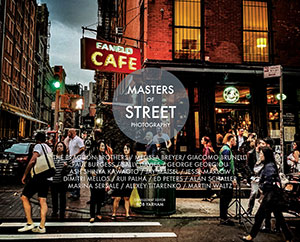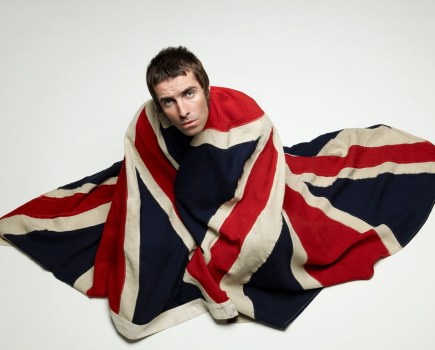
‘Untitled,’ Bondi Beach, Sydney, Australia, taken by Marina Sersale on an iPhone
Only a few decades ago, the term ‘street photography’ didn’t really exist, even though what is claimed to be the world’s first photograph, taken by Joseph Nicéphore Niépce in 1826, shows an urban scene. While more formally posed portraits and urban or rural landscapes were fashionable in the 19th century, a lot of early travel and documentary photographers were, of course, taking photographs of street scenes. By 1897, French photographer Eugène Atet was consciously taking images of a Paris which he saw expanding and developing very quickly, as more and more people flocked to the capital. As well as capturing old buildings, he was keen to record ordinary people on the streets, and how they lived their lives. Atget went on to influence future generations of big names, including Man Ray and the surrealists, Henri Cartier-Bresson, Diane Arbus, William Klein and so on. Martin Parr, arguably Britain’s best known photographer along with David Bailey and Don McCullin, is also best known for a lot of his street work.
Fast forward to the present day, and street photography now tends to be seen as a discreet, candid type of image making which records the complexities and quirks of our modern, very urbanised age, often using visual puns and wry juxtapositions in creative new ways. Or it can go down a more documentary road, with the emphasis on recording the decisive moments of modern life as it unfolds, or just interesting characters you see on the pavement. Smartphones have revolutionised the genre too, and to an extent, everyone is now a street photographer. This is not to say that the craft of street photography is easy to acquire, however, and there is a big demand for tuition from experts (type ‘street photography courses’ into Google and 199,000,000 results pop up).
You don’t need to sign up to a workshop to enjoy street photography, however, and there are some great books on the subject, including a new one from Ammonite Press. Masters of Street Photography does a great job of exploring how 16 leading lights of the genre go about their craft, and while it can never be the last word on this very diverse subject, it gives a great overview of current trends and best practice. As editor Rob Yarham explains, ‘Be it a decisive moment or not, street photographs work best when they capture the emotional and context of their subject matter.’
This said, there is an incredibly diverse range of street photographers included in the book, who are shooting in very different locations all over the world. This international scope is only fitting, as street photography is very much a vibrant and evolving art form. Their images not only record modern society but ask questions about it, arguably making street work more relevant and poignant than many other forms of contemporary photography. Also, the ‘street’ itself will often be different every time you visit it, even more so in very fast-developing parts of the world such as China, Southeast Asia and India. What approach you follow is very much a matter of personal choice, and Masters of Street Photography reveals a lot of very diverse ways of working. Some leading exponents, such as Jesse Marlow, are drawn to the use of abstract shapes and strong colours, following a very ‘graphic’ route; others, such as Rui Palha, are more about capturing atmosphere and emotion, with a lot of powerful portraiture. As this fascinating book reveals, it’s really about capturing what you find interesting and compelling about your subject matter, be it in Birmingham or Beijing.

‘Grandma with Grandchild’ by Alexey Titarenko
Spoiled for choice
In terms of equipment, street photographers are spoiled for choice, which is great news if this book inspires you to give this genre a go, or take it more seriously. At the entry level, most modern smartphones are more than capable of taking great street shots, particularly as the best ones now o er similar levels of control to a standalone camera. Meanwhile, innovative features such as Night Sight on the Google Pixel phones, for example, enable you to get great results when the sun goes down. The other advantage of using a phone is that it’s nearly always with you.
Moving up a level, there is now a huge range of light and portable mirrorless cameras which deliver great results without weighing you down or instantly marking you out as a photographer; one immediately thinks of Fujifilm’s nifty and pocketable X series of APS-C mirrorless models, or the classically designed and wonderfully compact Olympus OM-D line-up, complete with sharp lenses you can fit in your hand. While a lot of full-frame mirrorless cameras are getting as bulky as DSLRs, good options for high-resolution images include the Sony A7 III with a smallish prime, such as the Zeiss 35mm f/2.8 or 55mm f/1.8. Your choice of lens is obviously very important, and while the great street photographers of the past, such as Cartier-Bresson, favoured classic 35mm and 50mm primes, a reasonably discreet zoom lens obviously gives you more flexibility. There are now many more mirrorless and compact cameras with silent shutters too, which makes the candid street photographer’s job much easier. In many ways, gear is the easy part.
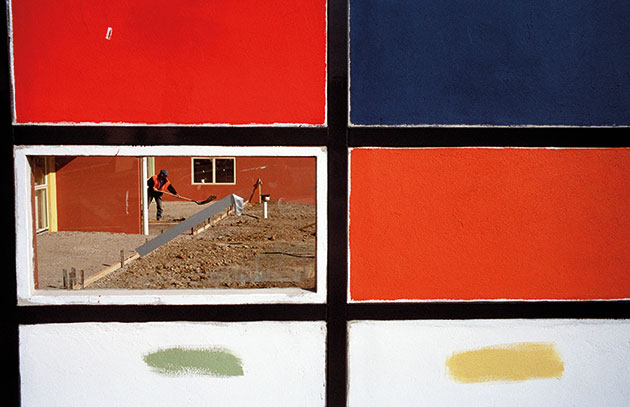
‘Six Panels’ (2009) taken in Melbourne, Australia, by Jesse Marlow
Understand the legalities
Before getting some practical tips from some of the photographers in the book, it’s important to deal briefly with the elephant in the room (or on the street), namely the legal aspects. A lot of potential street photographers are put off by worries about attracting the wrong kind of attention, be it from aggrieved subjects who don’t want to be photographed, through to security guards and the police. Others are just shy. Every country is different, but in the UK at least, you have more rights than you probably realise (see below). If you are in any doubt, or encounter any problems while shooting, always seek professional legal advice.
Finally, get some business cards made. If one of your subjects does take offence, they often calm down when you freely identify yourself as a serious photographer or offer to share your pictures with them (perverts and terrorists are unlikely to offer you their card, right?) Never feel you need to be shifty or somehow feel guilty about following the endlessly rewarding pursuit of street photography. The photographers in this book certainly don’t.
The law of the street
- Public right of way If you’re on a public right of way – such as a public pavement, footpath or public highway – you’re free to take photographs for personal and commercial use so long as you’re not causing an obstruction to other users or falling foul of anti-terrorism laws or the Official Secrets Act.
- Pictures of people Photographers can use their pictures of people taken in public places as they wish, including for commercial gain. While this is reassuring, common sense does need to be applied. A lot of pedestrians in the UK won’t react favourably if you go right up to them without any kind of introduction and shove a long lens in their face.
- Sensitive subjects Take care where children are involved, and you also need to be sensitive to cultural and religious differences (when taking photographs of Muslim women, for example). For a fuller guide to your rights under the law, see this excellent page on the Urban 75 website: https://bit.ly/2KCZOp9.
- Seek clarification If you are questioned by a member of the public, try to remain respectful and be prepared to explain yourself. Most people will question your motives out of sheer curiosity so don’t be too quick to judge. If someone suggests you are breaking the law (and you know otherwise), ask for clarification.
- Know your rights We’ve also put together a comprehensive guide of your legal rights on our website which will give you a better chance of staying on the straight and narrow. Disclaimer: this article is not a comprehensive legal guide, so always seek specialist legal advice if you have questions or concerns.
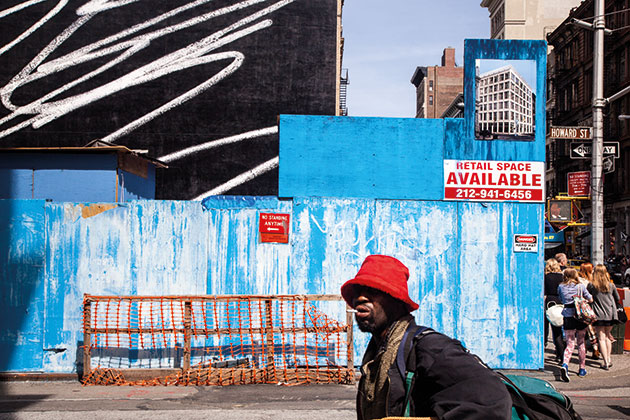
‘Untitled’, Manhattan, New York, taken by Ed Peters
Advice from the masters
Alan Schaller
‘There are certain things that can be enhanced in black & white, such as shape, structure, line and even human expression. I made it my mission to do something fresh – a modern twist on black & white photography. I started off emulating others but found my own direction once I had the skills.’
Alexey Titarenko
‘For long exposures you need to work with a tripod. Shooting with a tripod in the street may get you into jail, even in New York (I have been threatened with arrest several times by the NYPD)… I developed strategies for keeping a low profile!’
Marina Sersale
‘Be patient and keep your fingers crossed: if you wait long enough, something interesting is bound to happen. My second tip is to prepare yourself: be ready with your camera or phone, and when you’re at home do your homework. Study other photographers who inspire you because there’s always something new to learn.’
Jay Maisel
‘Humour is the saviour in a horribly conflicted world. Your nature shows in your work. I like to have a good time, and to laugh. I’m not a “funny” photographer like Elliott Erwitt, but if I see positive stuff it’s going to get way more play from me than something depressing.’
Martin U Waltz
‘Darkroom techniques are very exciting artistic tools. For example, reducing the silver adds depth or light; toning, if used properly, can change an image to what you’d call in music a major or a minor key. And it’s the same for density and contrast. But the process is very intuitive.’
Ed Peters
‘I’m mostly using 28mm and 35mm lenses. they’re good for juggling multiple elements into a composition. I also use rangefinder cameras. Unlike a single lens reflex camera, I can prefocus the lens, stop it down and have a good idea of what will be in focus. When I look through the viewfinder everything is clear and sharp, which makes it easier to compose complicated compositions.’
Dimitri Mellos
‘A photograph should be emotionally complicated, both in terms of the people depicted and the emotions it evokes in the viewer. I am more interested in images that pose questions which remain suspended, rather than ones that provide simplistic, straightforward messages. I abhor crude visual puns and simplistic jokey images.’
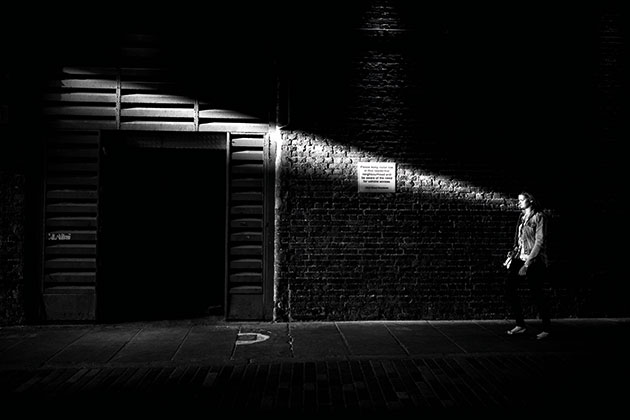
‘Untitled,’ taken by Alan Schaller in London
Kit list
- Mobile phone Smartphones are capable of taking great street shots – they are light, portable and, crucially, discreet. Some models have similar levels of control to a standalone camera.
- Mirrorless camera Delivering great results without weighing you down, mirrorless cameras are a great choice for street photography. The Fujifilm X-T3 can shoot 30 frames per second and offers a resolution of 26.1MP.
- Spare batteries Carry plenty of memory cards and spare batteries. If your camera has a double card slot use it as extra backup. To save battery power avoid ‘chimping’ – reviewing every picture immediately after shooting.
- Prime lens A quality prime, such as the Zeiss 35mm f/2.8, can be great for street photography. It can be tempting to keep your distance and use a zoom, but be brave and move in a bit closer.
- Shoulder bag When it comes to bags you need something that is comfortable, waterproof, and discreet. The Billingham Hadley Small Pro is an ideal choice as the padded inserts can be removed to convert it into a ‘casual’ bag.


